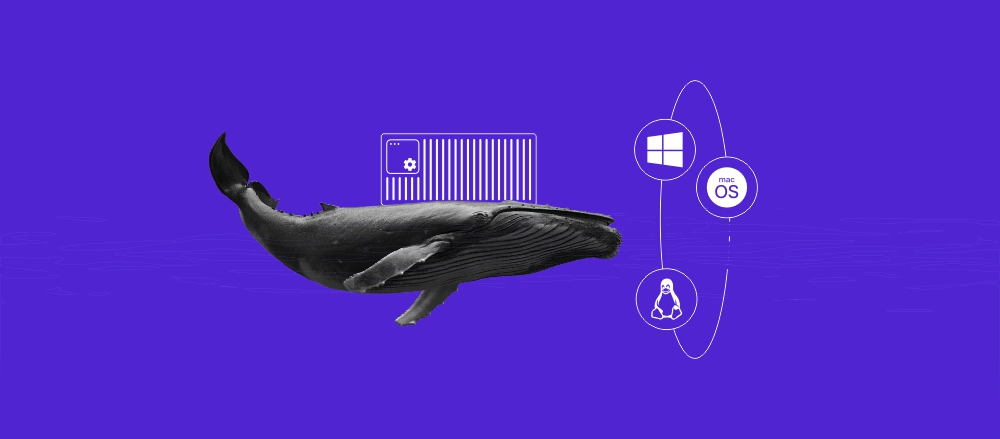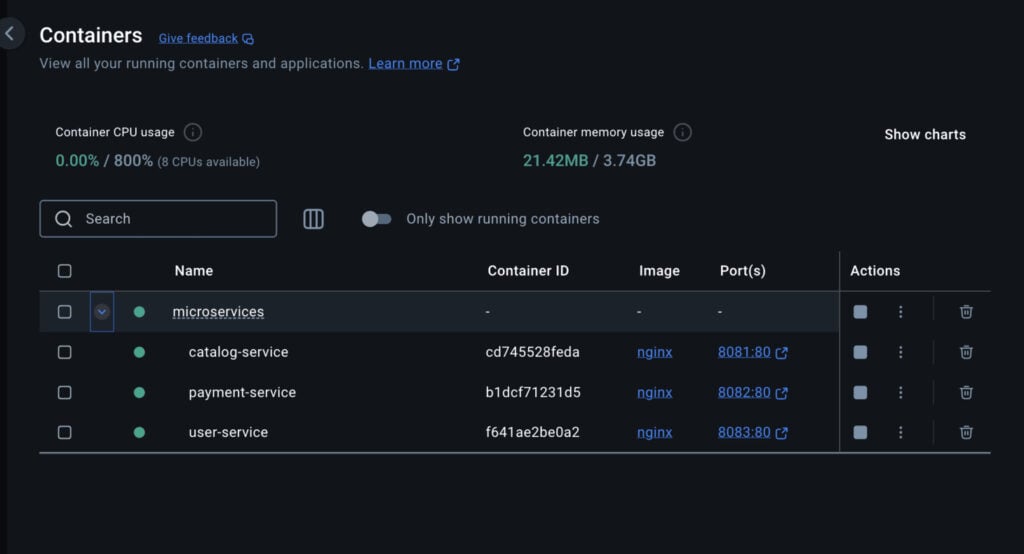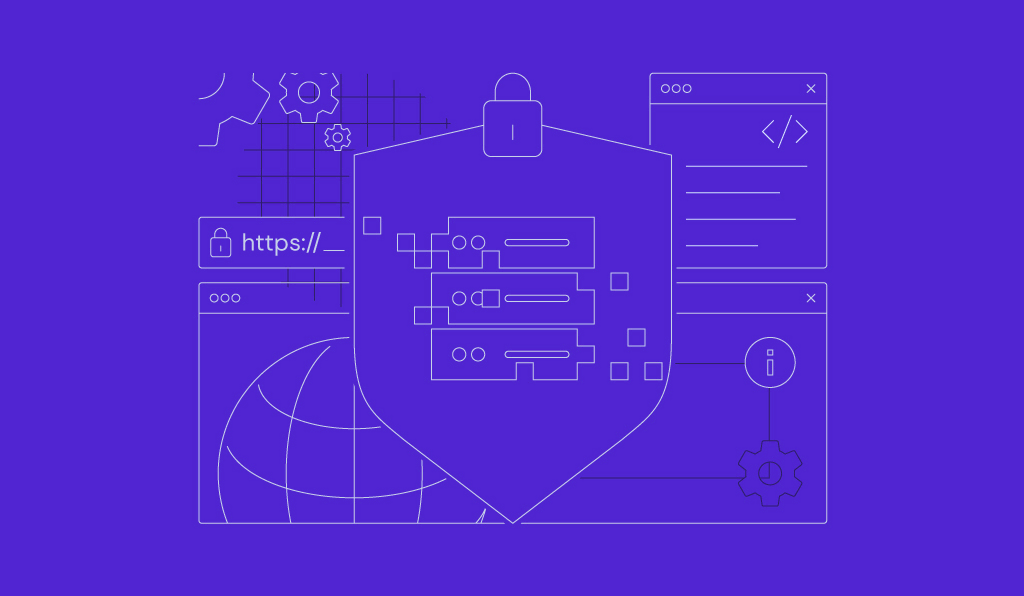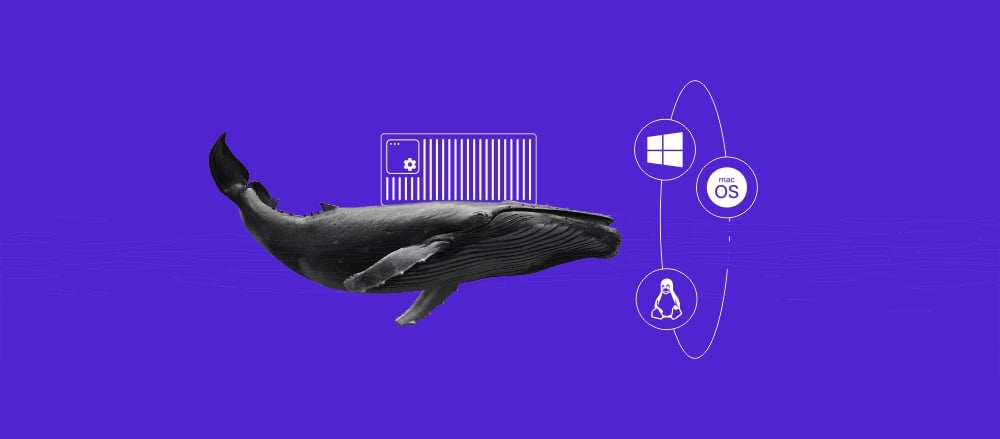15 popular Docker use cases for developers in 2025

Thanks to Docker’s containerization technology, developers are able to neatly package every part of their application and run it consistently across different environments, from local machines to production servers. This makes deployment, scaling, and management a breeze, and development processes more agile and efficient.
In this article, we will explore 15 of the most popular Docker use cases: real-world scenarios where developers get the most value from this powerful tool.
Download free docker cheat sheet
1. Simplified software development and deployment
Docker’s main draw is that it supports the entire development lifecycle. Before Docker, keeping code running consistently across different environments was complicated. Apps on the same machine could conflict with each other. For example, two projects needing different versions of the same library could easily break things and lead to unexpected behaviors, causing bugs and crashes.
The whole “it works on my system” problem was a thing, and while solutions like virtual machines help with some of the issues, they still entail a good degree of overhead. Docker, however, packages code, dependencies, and runtime into one container that developers can now replicate across environments as they are, keeping each application separate and functioning on its own.
2. Microservices architecture
When it comes to implementing microservices, Docker is a solid solution. It allows modular app development, which means each microservice can reside in its own container. Take, for example, a multifaceted application such as an e-commerce platform.
If your team and code base are big enough, microservices architecture is a common choice. In a microservices architecture, each part of your application (think accounts, payment, shipping) is built and deployed separately. If your team or codebase is large, keeping components independent just makes sense.
Here are some of the benefits of using Docker for microservices architecture:
- Isolation. You can run each microservice with its own dependencies, libraries, and packages, saying goodbye to conflicts. This means a microservice can run independently and be transferred as-is across environments with no extra setup beyond its Docker container.
- Infrastructure support. Containers can run on various platforms, such as VPS providers (like Hostinger VPS) and Kubernetes clusters.
- Scalability. Scaling is easy with Docker, and can be further simplified using orchestration tools like Kubernetes, Docker Swarm, and Amazon Elastic Container Service (ECS) to manage scaling and availability automatically.
- Polyglot architecture. You can write code in any language—Python, Java, Node.js, Go, and more—and deploy it uniformly using Docker containers.
- Consistency. Developers and operations teams share the same container image, ensuring development, staging, and production environments behave identically.
- Speed and tools. Docker is fast, lightweight, and provides built-in tools for logging, monitoring, and network management out of the box.

3. Continuous integration/Continuous deployment (CI/CD)
Developers pair Docker with CI/CD platforms to better their processes, enable continuous rapid deployment that keeps apps live even during frequent releases, and publish images to registries such as Docker Hub.
Among the benefits of using Docker with continuous deployment platforms, we have:
- Immutable images. Once an image is built, it’s immutable, which means it can be deployed across multiple development environments.
- Consistency. Developers and CI/CD tools (like Jenkins, GitLab CI, GitHub Actions) can run containers using the same Docker image.
- Standardized deployment. Whether you’re pushing to dev, staging, or production, deploying containers will remain the same.
- Isolation. Docker allows each step in the CI/CD pipeline to run in a clean environment, which avoids conflicts and disruptions.
- Reproducibility. Previous versions of containers can be redeployed with a simple tag change.
- Speed. Because containers can spin up in seconds, build and test cycles are faster, and cached Docker layers reduce the need to rebuild entire environments each time.
4. Application isolation for development
Keeping features and branches separate in application development is important, whether you are using a monolith or microservices infrastructure. And for testing and optimized development, it’s crucial to be able to replicate production environments locally as closely as possible.
Fortunately, with Docker, both are within reach, and more. When building an app, Docker can:
- Replicate production setups. Get a feel for the application in its true, live state as you work.
- Reduces environment-related bugs. When you run an app in Docker, you’re not just executing your code, but you’re also bundling everything the app needs. This way, you can avoid build failure caused by missing dependencies.
- Simplifies debugging. Developers can debug in a controlled environment that remains consistent.
- Avoids local pollution. By allowing each feature/branch to run in its own isolated Docker container.
5. Scalable web applications
Docker containers can support your team’s efforts to develop and deploy apps that never leave your customers in the dark. Take our ecommerce platform example again, but this time imagine it as an application that has just recently begun to see a large influx of visitors.
Things are taking off, and sudden high traffic can be as exciting as it can be problematic if your app won’t scale properly. Here is how Docker can help with that:
- Stateless architecture. Apps in Docker tend to be stateless, which makes it easier for containers to handle any request.
- Rapid horizontal scaling. Docker containers are fast and lightweight, allowing you to run more container instances to scale out your web app with ease. You can quickly add 5-10 more containers to your app to handle a sudden increase in traffic.
- Orchestration. Adding Kubernetes to the mix will give you load balancing, health checks, rolling updates, and traffic-based autoscaling, all of which support production-grade scalability with very little manual setup required.
- Consistent deployments. Because Docker ensures the same app environment everywhere, you can scale the same image without worrying about inconsistencies.
6. Hybrid cloud deployments
When working with hybrid cloud deployments, where you have workloads run across both on-premises and cloud environments, you’re going to need a lot of flexibility to keep things hassle-free. Docker is here to help:
- Portability and flexibility. Your Docker self-contained image that stores your application and all its dependencies can run as-is on multiple cloud environments, on-premises services, and Edge devices.
- Consistency. Thanks to an identical OS layer, stable environment variable, and pre-installed dependencies, Docker makes sure that your app behaves the same everywhere.
- Gradual cloud migration and cloud bursting. With Docker, you can start on-prem, then shift workloads to the cloud over time (gradual cloud migration), or move workloads to the cloud temporarily when on-prem capacity is full (cloud bursting), which lets you avoid the headache of re-architecting your application.
- Cost-efficiency. Docker makes hybrid cloud deployments more cost-effective by letting you use resources more efficiently, scale only when you need it, and avoid expensive infrastructure overhead.
7. Cloud-native apps and Kubernetes integration
As we have seen, Kubernetes can be a dynamic ally for your Docker-powered applications. Docker containers are Kubernetes-native workloads, and these two can work together to support automated deployment, scaling, and management of cloud-native applications.
Here are some of the main benefits of Docker in this scenario:
- Cloud-agnostic portability. Docker and Kubernetes work together across AWS, Azure, GCP, or on-prem, which gives your team the freedom to choose or change platforms without rewriting code.
- Automated deployment. Kubernetes uses manifests to automatically deploy or update containers without manual intervention, which in turn enables rolling updates and zero-downtime deployments, meaning your users will never be left out.
- Automated scaling. Kubernetes, too, supports automated scaling. It monitors container resource usage (CPU, memory), automatically adds or removes container instances based on demand, and quickly adapts to spiking or dropping traffic.
- Automated management. Kubernetes also continuously monitors container health and restarts failed containers automatically. Additionally, it manages networking, storage, and service discovery automatically.
8. Running legacy applications
Legacy code can be a headache, but preserving old systems is often necessary. Docker lets you containerize old dependencies and configurations, so you can run legacy apps in modern development environments without any need for extensive re-engineering. Here is how:
- Dependency encapsulation. We saw that what Docker does best is isolation and encapsulation. This proves particularly helpful when working with legacy code, as Docker can run apps with outdated libraries or OS versions without polluting your host system.
- Improved portability. Docker lets you swiftly package your legacy apps to run on any infrastructure (cloud, on-prem, dev machine).
- Extended lifespan. Efficient packaging means that you can keep legacy apps running safely even if the original environment is no longer supported.
- Simplified migration. And if you want to move your legacy app into newer infrastructure (like Kubernetes or cloud VMs), you can of course use Docker to do this, without full rewrites.
9. Big data and analytics
Data scientists and engineers use Docker containers to package their analytics tools and big data jobs, so they can easily recreate the same setup anywhere and scale complex workflows without delay. Here are a few more benefits of using Docker when working with big data:
- Fast, experimentation-friendly setup. Big data stacks can be tricky to configure. Fortunately, Docker can load pre-configured containers in seconds, helping data scientists and analysts who need quick and disposable environments.
- Workload isolation. With containers that isolate tools, processing jobs, and environments, you can easily run multiple user experiments or frameworks in parallel, avoiding dependency conflicts entirely.
- Reproducibility for pipelines and ML models. Docker is critical for data pipelines and ML research that needs to be reproducible. You can reuse the exact same code, libraries, and configurations in every run or training pipeline.
- Scalable architecture. Docker’s affinity with orchestration tools (Kubernetes, Docker Swarm) allows for easy scalability of data processing pipelines based on workload.

10. Testing and staging environments
If your testing stage does a lot of heavy lifting, especially when working with a test-driven development (TDD) approach, Docker lets you set up throwaway test environments that mirror production, helping you identify issues and bugs early and get faster feedback during development. But there is more:
- Reproducible test environments. You can safely run tests in the same environment every time, forgetting overhead and dependency issues.
- Isolated test runs. Each test suite or feature can run in its own container, which prevents side effects from shared state or config.
- Parallel testing. Multiple containers can run tests in parallel, speeding up the CI/CD pipeline.
- Clean rollbacks. Containers can be destroyed and rebuilt quickly, making it easy to reset the environment between test runs.
- Staging environments mirroring production. Stage environments can be built from the same Docker images used in production, ensuring they behave identically.
- Safe experimentation. You can try out new configurations, integrations, or services in staging without risking the production environment.
11. Data processing pipelines
Building a data processing pipeline involves several steps to automate ETL (Extract, Transform, Load) processes. Without Docker, this might mean manually installing and configuring different tools and environments, which in turn often means overhead, dependency conflicts, and inconsistent behavior across machines.
However, with Docker, these problems are quickly eliminated.
Adopting Docker for your data processing pipelines offers a range of advantages:
- Consistency across environments. Each stage of your pipeline goes in an isolated and reproducible container, so that you can run it without worrying about lengthy manual setups.
- Isolation of components. With each tool (e.g., Kafka, Spark, Airflow, PostgreSQL) running in its own container, your data processing pipeline becomes modular and easily maintainable.
- Scalability for large datasets. With Docker, you can scale those components of your pipeline that may need to handle large workloads (like data processors or workers) horizontally and independently.
- Lower resource overhead. Containers are lighter and nimbler than virtual machines, which makes them more fitting for distributed data processing tasks.
12. DevOps automation
Docker and DevOps are a great match because of Docker’s ability to make each step of the DevOps pipeline so much easier.
It streamlines operations from environment setup all the way to deployment, and it facilitates the whole process with automation, efficient resource utilization, and scalability. Here are some specific benefits of using Docker for DevOps automation:
- Consistent and reproducible environments. Docker keeps environments consistent and manageable, and eliminates environment drifts.
- Simplified infrastructure management. Infrastructure components and dependencies are defined as code in Dockerfiles, making it easier to provision, update, and version control environments.
- Seamless integration with CI/CD tools. Docker’s portability and image layering facilitate the management and scaling of automated builds, tests, and rollouts.
- Improved scalability and flexibility. Microservices packaged as containers can be deployed independently and automatically scaled based on demand.
- Quick rollback + fault isolation. Versioned Docker images make it simple to roll back faulty deployments, which means issues are isolated and don’t affect the entire system.
13. Edge computing and IoT
Without containerization technology, managing edge computing and IoT applications becomes a complex and unreliable endeavor. This is due to inconsistent environments, diverse hardware required, manual installations, and limited resources on edge devices.
Docker can help developers manage and deploy IoT devices in a number of ways:
- Resource efficiency. Because Docker containers running Linux share the host OS kernel and don’t require a full operating system for each instance, they drastically reduce CPU, memory, and storage usage. This makes them a great choice for edge devices with limited hardware resources. On platforms like macOS and Windows that run Linux containers, Docker uses a lightweight virtual machine to support Linux, still offering better efficiency than traditional VMs.
- Remote deployment and updates. Containers can be remotely deployed, updated, or rolled back across thousands of IoT devices from a central location, which reduces the need for on-site maintenance.
- Modular and isolated workloads. Multiple services (data collection, local processing, alerts) can run at the same time in separate containers, which enhances both maintainability and fault tolerance.
- Improved network efficiency. Docker allows services to run locally on edge devices, so data can be processed locally (filtered, aggregated, and analyzed) before being sent to the cloud. This reduces the amount of data sent over the network, lowering bandwidth consumption and cutting down latency.
14. Security and isolation
Using Docker containers is not just about convenience. By definition, isolation-prone containerization technology enhances security across your application and development environments. Here is how:
- Reduced attack surface. Containers only include the dependencies an application needs to run, therefore minimizing exposure to unnecessary system components that could be exploited in case of an attack.
- Isolation by design. If one container happens to be compromised, it doesn’t affect others or the host OS.
- Secure immutable infrastructure. Containers are typically deployed from read-only images, which prevent unauthorized changes during runtime.
- Controlled access. Docker supports granular permissions (like user namespaces, seccomp, AppArmor, SELinux), which restrict what containers can do on the host system.
- Faster patching and rollback. You can easily reduce vulnerability windows by applying security patches, updating container images, and redeploying in a matter of minutes.
15. Database containerization
Containerizing your database cuts overhead and prevents issues like manual setup and configuration, environment drifts, and difficult versioning. Several popular databases like MySQL, PostgreSQL, and MongoDB support containerization, which is great news for your database-dependent application. Here are a few other ways Docker is great for your database:
- Portability. Packaged into Docker containers, databases can run easily across environments or be moved between servers and cloud platforms.
- Rapid provisioning. Databases can be launched quickly using preconfigured images for local testing, CI/CD pipelines, or rapid software development.
- Backups and restores: Thanks to snapshots of data volumes or containerized tools, you can automate backups and restores with minimal downtime.
- Version control. Developers are free to run different database versions in parallel for testing or gradual migrations.
- Simple management. You can automate lifecycle tasks (like setup, scaling, updates) by using Docker Compose or orchestration tools.

Conclusion
As we have seen, Docker is more than a nifty tool: it’s a paradigm shift that can turn a complicated software development workflow into a distant memory. It makes development faster and more reliable, simplifies testing and deployment, and takes care of the heavy lifting so you can focus on the most important parts of your project.
Key takeaways:
- Docker solves environment headaches by packaging apps and dependencies together.
- It’s lightweight and resource-efficient, perfect for devices with limited resources.
- Supports smooth CI/CD pipelines and quick database management.
- Works great with cloud platforms and orchestration tools for flexible deployments.
- Improves security with isolation and easy rollback options.
Start using Docker today to speed up your deployments and make development way smoother. Hostinger offers Docker hosting so that you can run your projects hassle-free anywhere.
Docker use cases FAQ
What are common use cases for Docker?
Docker is a leading containerization tool used by developers, data scientists, and analysts. Common Docker use cases include packaging apps, creating consistent dev and test setups, running CI/CD, and deploying microservices. How does Docker improve application deployment?
Docker bundles your app with all its dependencies into a container that runs exactly the same on any system and environment. This consistency reduces obstacles caused by different environments and dependency conflicts, makes deployment faster, and simplifies updates and rollbacks.
Can Docker be used for microservices?
Yes, Docker is perfect for microservices. Each service runs inside its own isolated container with everything it needs, from code and dependencies to runtime environments and test executions. This lets teams develop, deploy, and scale each service independently.
All of the tutorial content on this website is subject to Hostinger's rigorous editorial standards and values.


